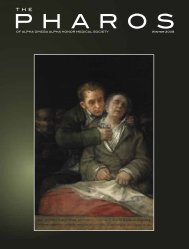Download The Pharos Winter 2011 Edition - Alpha Omega Alpha
Download The Pharos Winter 2011 Edition - Alpha Omega Alpha
Download The Pharos Winter 2011 Edition - Alpha Omega Alpha
Create successful ePaper yourself
Turn your PDF publications into a flip-book with our unique Google optimized e-Paper software.
credit for all these, sometimes leaving<br />
the contributions other investigators<br />
played in these advances forgotten or<br />
little noted. While he played a pivotal<br />
role in the clinical development of the<br />
accelerator and aggressively pushed its<br />
use forward, other clinicians at other<br />
centers were moving in the same direction.<br />
Dose escalation and contiguous<br />
uninvolved field therapy built heavily on<br />
the work of the Canadian Vera Peters,<br />
and an understanding of the logical<br />
pattern of Hodgkin’s disease spread was<br />
very much a product of his colleague<br />
Saul Rosenberg. Kaplan never did identify<br />
the elusive human tumor virus and<br />
monoclonal antibody success was left<br />
to others.<br />
Kaplan’s lasting scientific achievement<br />
was the rigorous investigation of<br />
Hodgkin’s disease. He and his associates<br />
pioneered the randomized clinical trial,<br />
answering one question and proceeding<br />
to the next in single institution studies<br />
with the single-minded goal of curing<br />
the disease and lessening the complications<br />
of therapy.<br />
Concurrent with his science, HSK, as<br />
his associates knew him, attempted to<br />
reshape Stanford’s medical school in his<br />
image. From the time he became chairman<br />
of Radiology, he assumed a leadership<br />
role in creating a research-oriented<br />
school as the university moved its medical<br />
school campus from San Francisco<br />
to Palo Alto. He was instrumental in recruiting<br />
a sterling faculty that included<br />
three future Nobel Laureates. As his<br />
department grew, he envisioned a nationally<br />
sanctioned comprehensive cancer<br />
center, but as his dream threatened<br />
to dominate the school, close colleagues<br />
withdrew support and the center never<br />
happened. This was a devastating and<br />
embittering defeat. His struggles, sometimes<br />
very contentious, with deans and<br />
other faculty were legendary, his failures<br />
and successes are carefully chronicled.<br />
<strong>The</strong>re were forays as well in the national<br />
scientific scene and HSK played<br />
a key role in refining the 1971 National<br />
Cancer Act that paved the way for a<br />
dramatic increase in funding for cancer<br />
research and NCI independence.<br />
Throughout his career, HSK developed<br />
a few close professional and<br />
personal relationships. <strong>The</strong>se were significant<br />
scientists whose common characteristic<br />
seemed to be the same drive,<br />
ambition, and dismissiveness toward<br />
others less forceful. Perhaps most interesting<br />
is the thorough account of his<br />
evolving friendship with Dr. Vincent<br />
DeVita, who was key in developing curative<br />
combination drug therapy for<br />
Hodgkin’s disease that rivaled Stanford’s<br />
radiotherapy efforts and who ultimately<br />
became the director of the National<br />
Cancer Institute. In interviewing over<br />
one hundred of his colleagues, patients,<br />
friends, and family members, Dr. Jacobs<br />
was able to bring detail to HSK’s fascinating<br />
and multifaceted life and his<br />
impact on others. Particularly revealing<br />
are first-person recollections of confrontations<br />
with associates and friends<br />
whose views differed from his. His<br />
close, though imperfect, relationship<br />
with his children is tenderly presented.<br />
Dr. Jacobs has authored a loving account<br />
of a powerful figure. While the<br />
chronology is painstaking, I’m not sure<br />
that one comes away with a balanced<br />
picture of this giant of American medicine.<br />
As Dr. Jacobs writes toward the<br />
end of her book, “anonymity wasn’t<br />
Henry’s way. If you had the chance to<br />
reach your goal, you grabbed it.” p310 He<br />
began poor with a very visible physical<br />
deformity, a brilliant mind and a desire<br />
to achieve. He worked tirelessly and<br />
with tremendous self-assurance built<br />
a scientific career that was outstanding.<br />
While not detailed in the book, at<br />
a time when radiation oncology was a<br />
relatively new discipline, his early trainees<br />
became department chairs at half<br />
a dozen academic medical centers. He<br />
had talents and a drive beyond most,<br />
but alienated many associates and his<br />
own brother. While warm and compassionate<br />
toward patients, he could be dismissive<br />
to associates. While he was very<br />
public in much of what he did professionally,<br />
his humanitarian work was carried<br />
out with much less flourish. He was<br />
a complex and flawed man, but indeed<br />
a visionary who brought a scientific<br />
rigor to the practice of oncology and<br />
helped move Hodgkin’s disease from an<br />
untreatable malignancy to one for which<br />
cure is now the rule. Dr. Jacobs’ book is<br />
a riveting read, meticulously covering a<br />
time of dramatic creativity in American<br />
medicine while also revealing the personal<br />
infighting that took place behind<br />
the scenes.<br />
Dr. Rogoway is a member of the editorial<br />
board of <strong>The</strong> <strong>Pharos</strong> and emeritus adjunct<br />
clinical professor of Medicine at Stanford<br />
University. His address is:<br />
266 Old Spanish Trail<br />
Portola Valley, California 94028<br />
E-mail: rogoway@stanford.edu<br />
<strong>The</strong> National Institutes of<br />
Health: 1991–2008<br />
John Kastor<br />
New York, Oxford University Press,<br />
2010, 271 pages<br />
Reviewed by Jack Coulehan, MD<br />
(AΩA, University of Pittsburgh, 1969)<br />
W hen I did my internship at the<br />
Hospital of the University of<br />
Pennsylvania, John Kastor was a rising<br />
star in Penn’s Division of Cardiology.<br />
He was also one of my favorite attending<br />
physicians, partly because of excellent<br />
teaching and obvious commitment to<br />
<strong>The</strong> <strong>Pharos</strong>/<strong>Winter</strong> <strong>2011</strong> 49














